If you’re considering undergoing a home renovation or having an extension added onto your home, it’s vital that you understand the rules and regulations around what permissions you need to make your build lawful. This is particularly important if you happen to live in a Conservation Area as there are more restrictions in place around construction, materials that can be used and whether or not you can exercise permitted development rights.
We break down what permitted development rights are, how they are impacted by Conservation Areas and what you need to know to give yourself the best chance of securing permission for your build.
What are permitted development rights?
Full disclosure: permitted development rights can be tricky to untangle and understand so, if you’d prefer to speak to someone about what they entail, I’d recommend book a free advice call with one of our in-house experts. If you prefer to read, then welcome – let's get started!
Permitted development rights are part of a scheme created by the government that allows you to get an extension or carry out home renovations without requiring full planning permission. As of a few years ago, the scheme has evolved to include larger projects and more options for home improvements.
What is a Conservation Area?
A Conservation Area is an area that’s protected by a series of building and planning restrictions to ensure that the original character of it is either retained or improved. Its importance is protected to conserve its integrity. The protected areas can range from country estates to old city suburbs or historical landmarks and more.
How does being in a Conservation Area impact permitted development?
The rules and regulations surrounding permitted development rights vary slightly in conservation areas than those outside – these restrictions can include Article 4 Directions. This means that you may need to carry out planning applications that in other areas wouldn’t necessarily be required – including:
- Residential changes to a property including cladding, double-storey extensions and certain types of windows.
- Building extensions onto retail properties – the appearance, for example, should match the existing building and there are restrictions to click and collect services.
- Restrictions to changes on agricultural land.
- Controls are in place for the materials used for schools, colleges, universities and hospitals.
All of that being said, it doesn’t mean that all permitted development rights are all removed. Certain works are allowed under the General permitted Development Order (such as small extensions that aren’t considered too disruptive).

How to find out if you’re in a Conservation Area:
There are plenty of ways that you can find out whether you’re in a Conservation Area.
- First of all, you can always book a free consultation call with us where we can run you through whether you’re in a Conservation Area and advise with our expertise and experience in mind how that may impact your proposed plans.
- Another way to identify whether your property falls into a Conservation Area is to locate your local council and get in touch with them directly. Each council will have a supplementary planning document (SPD) that will outline what’s allowed in their constituency. In addition to this, they’ll be able to direct you to Design Appraisals which are even more specific in stating what’s allowed or not allowed.
- Lastly, you can contact your local planning authority directly to get clarity on how your permitted development rights are impacted by being in a Conservation Area.
What are the next steps for getting your planning approved?
For the majority of changes to the outside of your home and your garden (including trees), you’ll need to complete a full planning application with your local council. This is a service that our in-house experts can help guide you through – learn more about how we can assist you with obtaining planning permission here.
You’ll need a detailed package prepared to make your case, including architectural drawings, proposed designs and any other relevant documents. We’d recommend hiring an architect to make this process run as smoothly as possible.

























